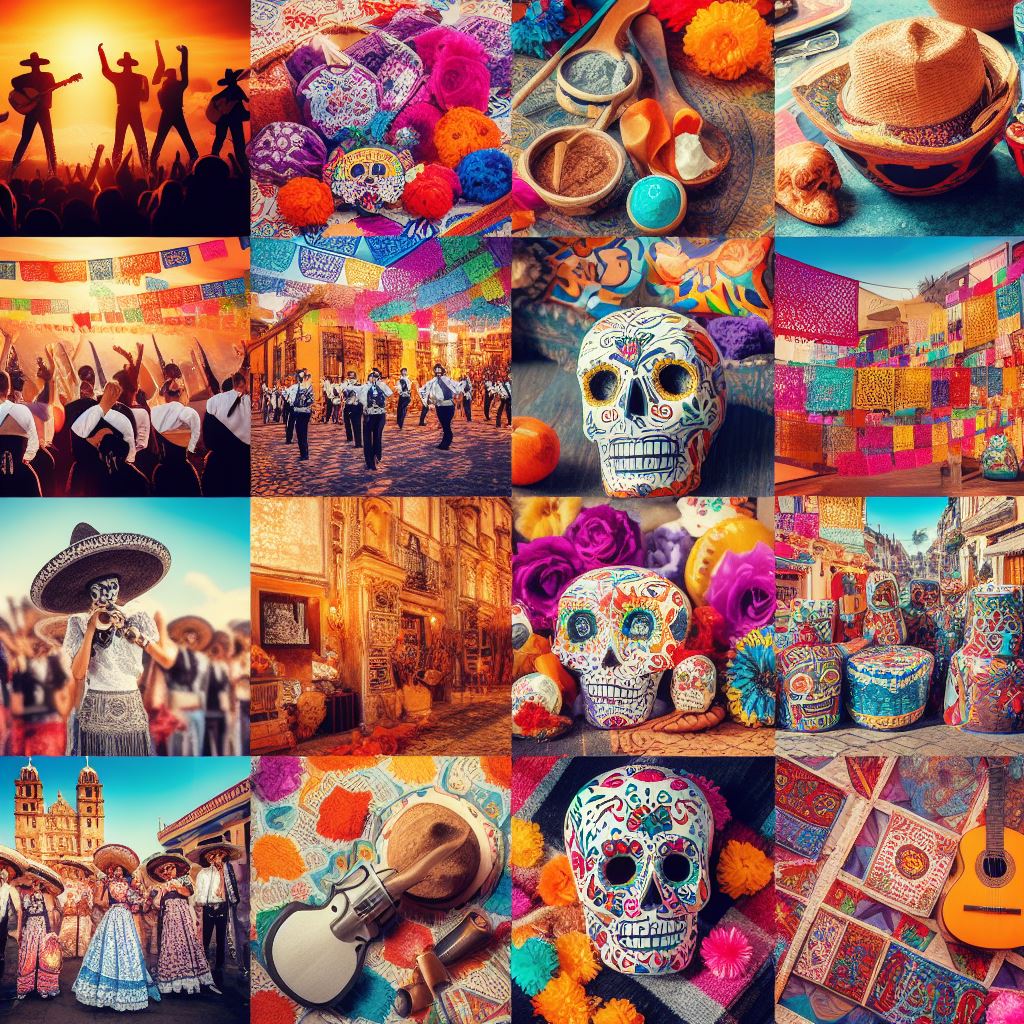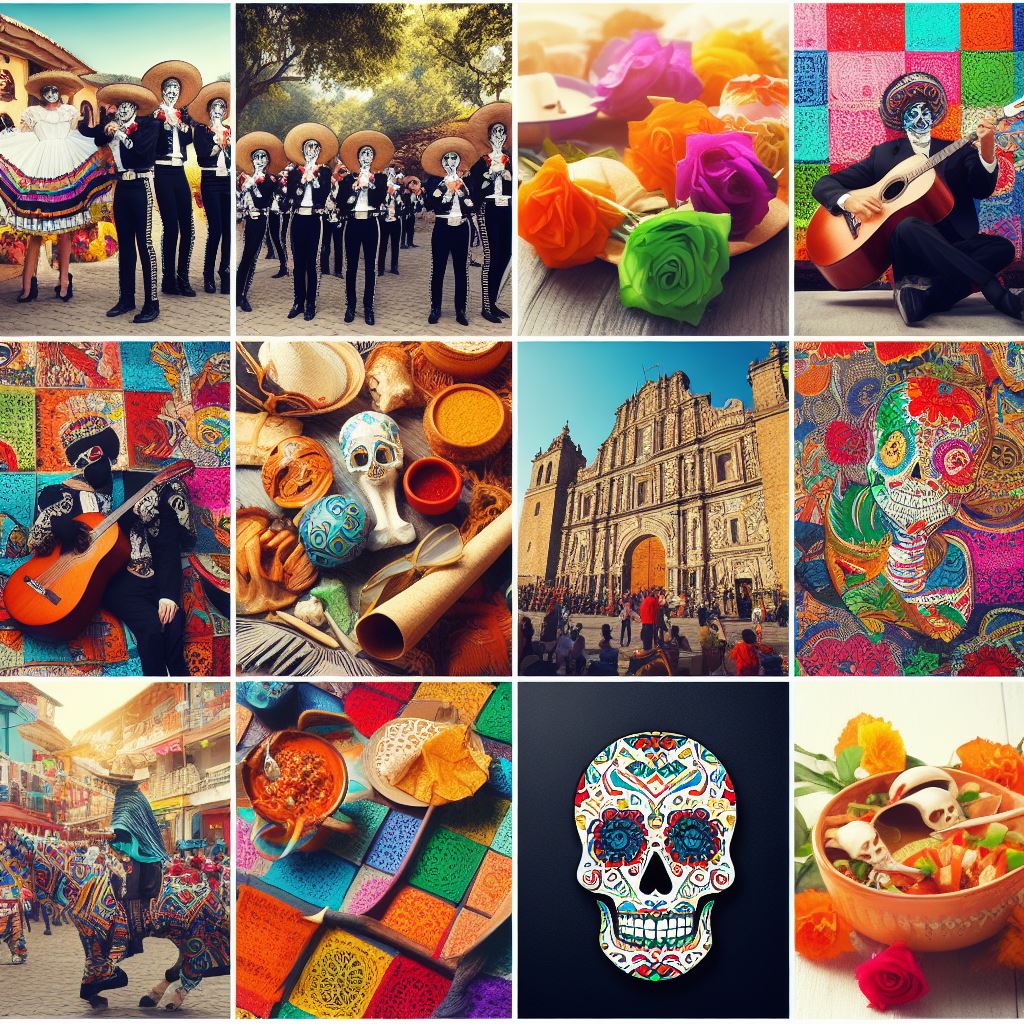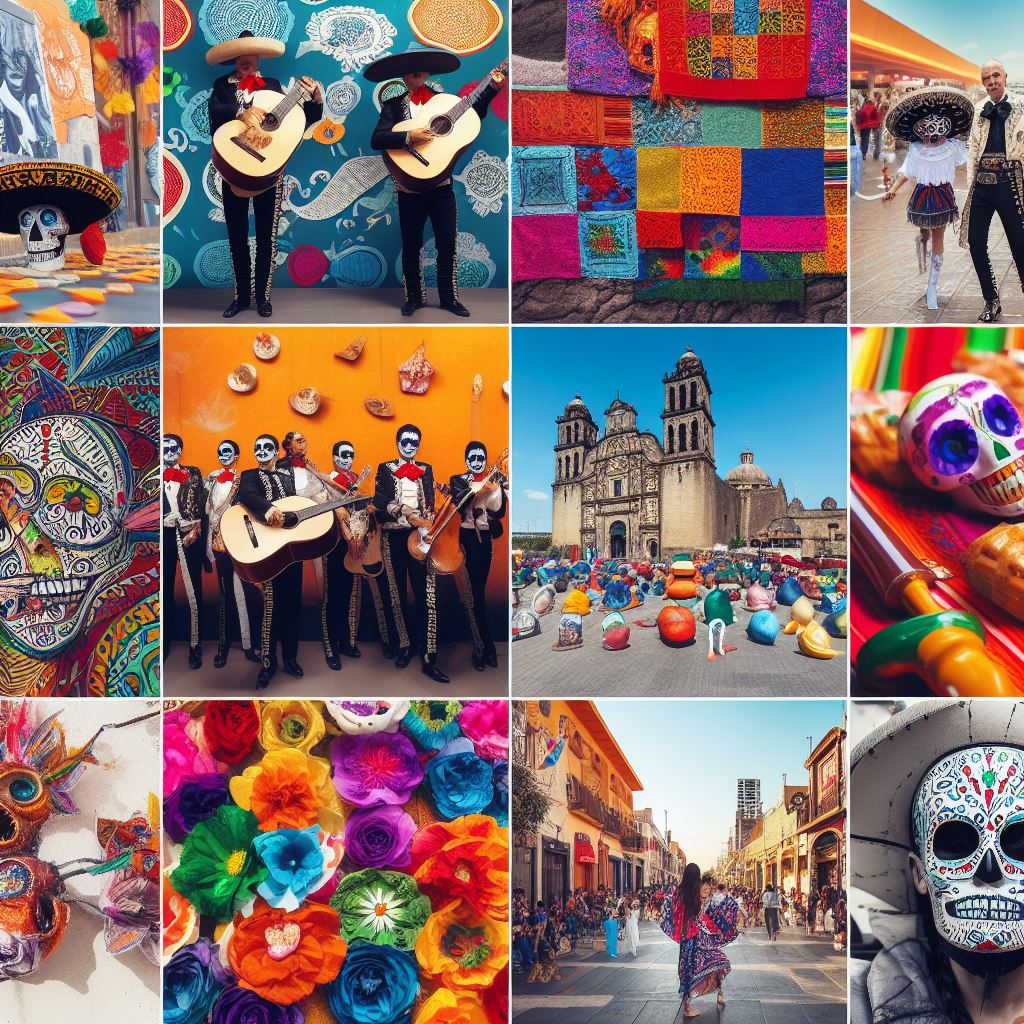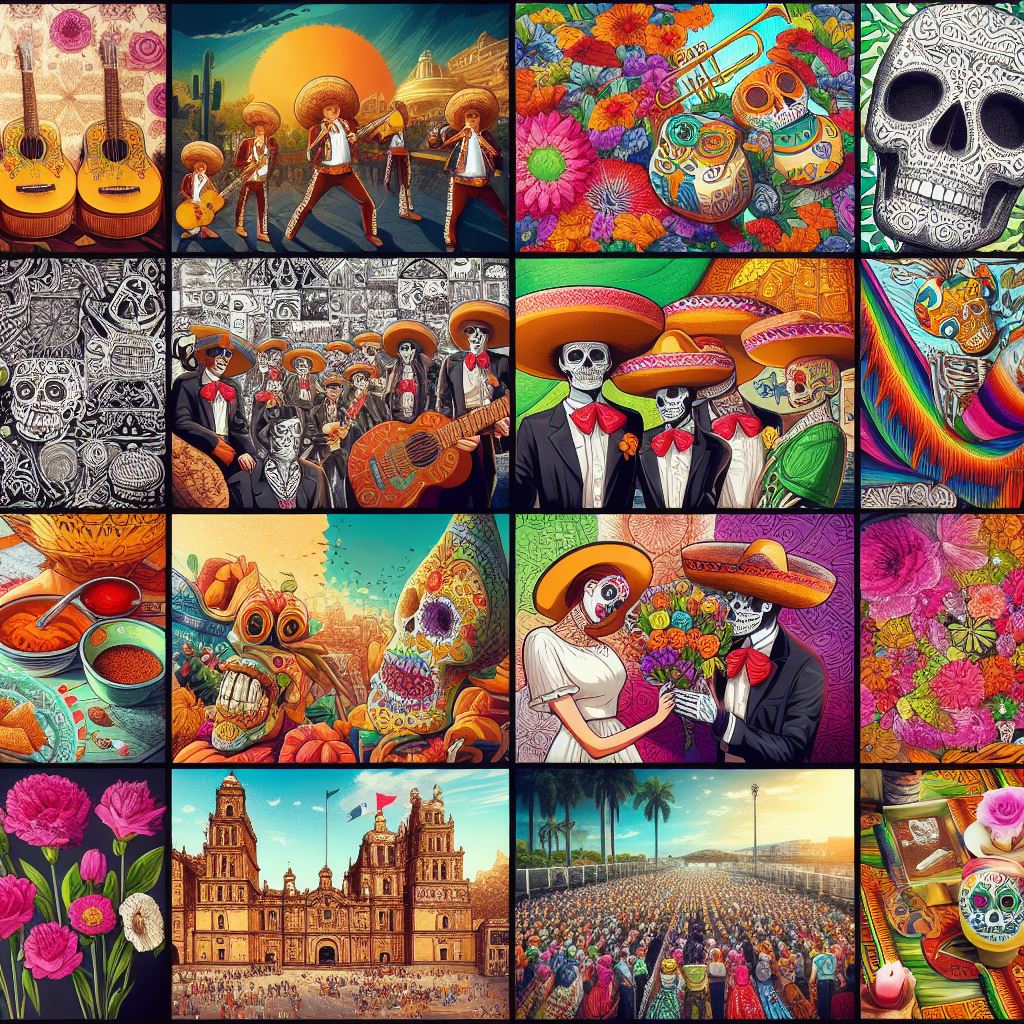Rich Tapestry of Mexico Culture and Traditions
Mexico, a land of vibrant colors, ancient civilizations, and deep-rooted traditions, beckons to be explored. This introduction sets the stage for our journey into the heart of Mexico Culture Traditions, shedding light on the myriad customs and practices that have shaped this nation’s identity over centuries.
Thank you for reading this post, don't forget to subscribe!
Overview of Mexican Culture and Traditions
A Cultural Kaleidoscope
Mexico’s cultural landscape is akin to a kaleidoscope, where every turn unveils a new pattern, a new story. The sheer diversity and richness of Mexican culture are awe-inspiring. From the mystical rituals of indigenous civilizations to the vibrant celebrations of modern Mexico, this nation encapsulates a multitude of traditions.
The Tapestry of Diversity
Mexico’s culture is not a monolithic entity but a mosaic of influences. It bears the indelible imprints of the indigenous peoples who once thrived here, such as the Aztecs and Mayas. The arrival of Spanish conquistadors in the 16th century added a layer of European influence. This chapter will explore how these historical influences have woven a tapestry of cultural expressions unique to Mexico.

Significance of Understanding Mexican Culture
A Window into a Nation’s Soul
Understanding Mexican culture is not merely an academic pursuit; it is a pathway to comprehending the soul of a nation. It allows us to peer into the beliefs, values, and aspirations of the Mexican people. Moreover, appreciating Mexican culture fosters mutual respect and bridges the gaps that divide us.
Cultural Enrichment and Global Harmony
In an increasingly interconnected world, cultural understanding is a cornerstone of global harmony. By delving into the cultural intricacies of Mexico, we embrace the beauty of diversity. This chapter will illuminate why grasping the nuances of Mexican culture is not just a curiosity but a crucial step toward a more inclusive and empathetic world.
Chapter 2. Historical Influences on Mexican Culture
2.1. Indigenous Roots
Mexican Culture’s Indigenous Tapestry
Mexico’s cultural tapestry is intricately woven with threads of indigenous heritage. As we explore the historical influences on Mexican culture, it’s impossible to overlook the profound impact of indigenous civilizations, such as the Aztec and Maya.
A Legacy of Great Civilizations
The Aztec and Maya civilizations are among the most renowned indigenous cultures in Mexico’s history. These advanced societies left an indelible mark on Mexican culture, which persists to this day. Here are some key aspects of their influence:
Contributions to Language and Art
Hieroglyphics and Codices: The Maya were pioneers in developing a complex system of hieroglyphics, which they used in their codices. These codices contained invaluable information about their culture, history, and astronomy.
Nahuatl Language: The Aztecs spoke Nahuatl, a language that has significantly influenced modern Mexican Spanish. Many Nahuatl words are still used in daily Mexican life, particularly in the names of places, foods, and plants.
Agricultural Advancements
Maize Cultivation: The cultivation of maize (corn) was a hallmark of both the Aztec and Maya civilizations. This staple crop not only provided sustenance but also played a vital role in religious ceremonies.
Religious Beliefs and Practices
Polytheism: Both the Aztecs and Maya practiced polytheism, worshipping a pantheon of deities. Their religious rituals included elaborate ceremonies, sacrifices, and the veneration of nature.
2.2. Spanish Influence
Shaping Mexican Culture: The Spanish Colonial Era
The arrival of Spanish conquistadors in the 16th century marked a transformative period in Mexican history. The Spanish influence, which lasted for nearly three centuries, profoundly impacted Mexican culture.
The Confluence of Two Worlds
The Spanish conquest of Mexico was a collision of worlds—Europe and the Americas. This encounter gave rise to a fusion of cultures, known as mestizaje, which continues to define Mexican identity. Here are some key aspects of Spanish influence:
Language and Religion
Spanish Language: The most obvious linguistic impact of the Spanish conquest was the introduction of the Spanish language. Over time, it merged with indigenous languages, giving birth to Mexican Spanish.
Catholicism: The Spanish brought Catholicism to Mexico, and it quickly became the dominant religion. Today, Mexico is one of the largest Catholic nations in the world. The syncretism of indigenous beliefs with Catholicism is a fascinating aspect of Mexican spirituality.
Architecture and Urban Planning
Colonial Cities: The Spanish introduced new architectural styles and urban planning concepts. Colonial cities, characterized by their central plazas and churches, remain prominent features of Mexican urban landscapes.
Cuisine
Fusion of Flavors: Spanish cuisine melded with indigenous ingredients, resulting in a unique Mexican culinary tradition. Staples like corn, tomatoes, and chili peppers became integral to Mexican dishes.
2.3. Modern Mexican Identity
The Tapestry Unfolds: Modern Mexican Culture
Mexico’s history is a testament to resilience and adaptation. As we delve into the historical influences on Mexican culture, it’s crucial to examine how these diverse threads have woven together to create the modern Mexican identity.
A Fusion of Heritage
Modern Mexico is a complex interplay of indigenous, Spanish, and global influences. It’s a nation that proudly celebrates its roots while embracing the diversity of the modern world. Here’s a glimpse of Mexico’s modern cultural identity:
National Symbols
Flag and Coat of Arms: The Mexican flag, with its green, white, and red stripes, and the national coat of arms featuring an eagle perched on a cactus with a snake, are iconic symbols of Mexican identity.
Cultural Expressions
Art and Music: Mexican art, from the murals of Diego Rivera to the folk art of Oaxaca, continues to captivate the world. Music, including mariachi, ranchera, and regional styles, reflects the rich tapestry of Mexican culture.
Festivals and Traditions
Cultural Celebrations: Mexico hosts a myriad of festivals and traditions, from the exuberant Day of the Dead to the vibrant Cinco de Mayo celebrations. These events showcase the nation’s cultural diversity and creativity.
In the chapters that follow, we’ll explore these influences and traditions in greater detail, allowing you to immerse yourself in the captivating world of Mexican culture.
Chapter 3. Key Mexican Traditions
3.1. Dia de los Muertos (Day of the Dead)
Celebrating Life and Remembering Ancestors
In the vibrant tapestry of Mexican traditions, few celebrations are as iconic and deeply rooted as Dia de los Muertos, or the Day of the Dead. This extraordinary holiday, celebrated from October 31st to November 2nd, offers a unique perspective on life, death, and the enduring connection between the living and the departed.
A Fusion of Beliefs
Dia de los Muertos is a fusion of indigenous and Catholic beliefs, illustrating Mexico’s syncretic spirituality. At its core, this celebration is a joyful commemoration of deceased loved ones. Here’s a closer look at its significance, customs, and celebrations:
Honoring the Departed
Ofrendas (Altars): Central to Dia de los Muertos are colorful ofrendas, or altars, adorned with marigolds, sugar skulls, and the deceased’s favorite foods and mementos. These ofrendas invite the spirits of loved ones to return and enjoy the offerings.
Cemeteries: Families gather at cemeteries to clean and decorate graves. Candles and copal incense are lit to guide the spirits’ way back to the living world.
Symbolism and Traditions
Calacas and Catrinas: Elaborate skeletal figures, known as calacas and the elegant Catrina, are iconic symbols of the holiday. They serve as a reminder of the inevitability of death and the importance of cherishing life.
Sugar Skulls: Intricately decorated sugar skulls, or calaveras, are both artistic expressions and sweet treats. They often bear the names of the deceased and are exchanged among friends and family.
Pan de Muerto: This sweet, round bread decorated with bone-shaped dough is a traditional Day of the Dead treat, symbolizing the circle of life and death.
Celebration and Remembrance
Feasting: Families come together to share meals featuring the deceased’s favorite dishes, ensuring that their spirits can enjoy the flavors of life once more.
Marigolds: Vibrant marigold flowers, known as cempasúchil, are believed to attract and guide the spirits. Their fragrance fills the air, leading the way home.
Calaveras Literarias: These witty, satirical poems and verses humorously depict the living, gently reminding them of their mortality.
Processions and Parades: In many Mexican towns and cities, colorful processions and parades fill the streets. Participants wear elaborate costumes and paint their faces as skulls, creating a festive atmosphere.
A Celebration of Life
Dia de los Muertos is not a somber occasion; it’s a joyful celebration of life and a profound connection with ancestors. It reminds us that death is a part of the human experience and offers a unique way to cherish the memories of those who have passed.
In the following chapters, we’ll continue our journey through Mexican traditions, exploring the rich cultural tapestry that makes Mexico’s heritage so captivating and diverse.

Chapter 4. Contemporary Mexican Culture
Exploring the Flavors, Styles, and Rhythms of Modern Mexico
Mexico’s cultural richness extends far beyond its historical roots. In this chapter, we delve into the dynamic and ever-evolving landscape of contemporary Mexican culture. From mouthwatering cuisine to vibrant music and dance, from traditional clothing to modern artistry, this is a celebration of Mexico’s vibrant present.
A Culinary Odyssey
1. The Heart of Mexican Culture: Cuisine
Mexican cuisine is a dazzling mosaic of flavors, colors, and textures. It’s a harmonious blend of ancient indigenous traditions and Spanish influences, creating a culinary landscape unlike any other.
2. The Essentials: Tacos, enchiladas, tamales, and more. We explore the staples that have captured the hearts and taste buds of food enthusiasts worldwide.
3. Regional Delights: Mexico’s diverse geography has given rise to regional specialties. From the spicy dishes of the Yucatan Peninsula to the seafood feasts of the coast, we tour the country through its cuisine.
4. Street Food Fiesta: Discover the joy of eating at vibrant street markets, where you can savor tacos al pastor, elote, and churros while soaking in the local atmosphere.
5. Sipping Traditions: Tequila and mezcal, Mexico’s iconic spirits, have a rich history. Learn how they’re made and enjoyed.
A Riot of Colors
1. Traditional Clothing and Textiles
Mexican attire is a visual feast of colors and patterns. We uncover the symbolism and cultural significance of traditional clothing, including the famous serape and rebozo.
2. Huipiles and Embroidery: Dive into the world of indigenous textiles and intricate embroidery, each stitch telling a story.
The Soundtrack of Mexico
1. Music That Moves the Soul
Music is the heartbeat of Mexican culture. Explore the passionate rhythms of mariachi, the foot-tapping beats of cumbia, and the soulful melodies of bolero.
2. Dance to the Beat: Discover regional dances like the jarabe tapatío and the colorful choreography of traditional Mexican dances.
Artistry in Every Form
1. A Canvas of Creativity
Mexican art is a reflection of its people and history. We explore the world of muralists like Diego Rivera, the whimsical folk art of alebrijes, and the modern Mexican art scene.
2. Craftsmanship: From Talavera pottery to Oaxacan wood carvings, Mexico’s artisans create treasures that bridge the past and present.
Festivals that Enchant
1. Beyond the Traditions
While we’ve explored key Mexican traditions, this section highlights additional cultural festivals and celebrations that showcase the diversity of Mexican culture.
From the joyous Guelaguetza in Oaxaca to the colorful Feria de San Marcos in Aguascalientes, these celebrations offer a glimpse into Mexico’s zest for life.
As we journey through the vibrant tapestry of contemporary Mexican culture, you’ll gain a deep appreciation for the creativity, artistry, and flavors that define this captivating nation.
Chapter 5. The Role of Religion
Shaping Beliefs and Practices in Mexican Culture
Religion holds a profound place in the hearts and lives of the Mexican people. In this chapter, we delve into the role of religion in shaping Mexican beliefs, practices, and the cultural landscape. From the influence of Catholicism to the unique syncretism seen in Mexican spirituality, religion weaves its tapestry throughout the nation.
The Dominance of Catholicism
1. Catholicism in Mexico
Catholicism arrived in Mexico with the Spanish conquest and has since become the predominant religion. It’s not just a belief system; it’s a cultural cornerstone. Explore the deep-seated Catholic traditions that permeate Mexican society.
2. Saints and Devotions
Mexicans have a special affinity for saints, each associated with specific attributes and patronages. Learn about the veneration of saints like Our Lady of Guadalupe and the importance of pilgrimage sites.
3. Religious Celebrations
Religious festivals and processions are vibrant expressions of faith in Mexico. Discover the significance of Semana Santa (Holy Week) and the grand celebrations of the Virgin of Zapopan.
Syncretism: Bridging Worlds
1. Blending Beliefs
One of the most fascinating aspects of Mexican religion is syncretism, the merging of indigenous beliefs with Catholicism. Explore how ancient gods like Quetzalcoatl found new life in the form of Christian saints.
2. Day of the Dead
Dia de los Muertos, or the Day of the Dead, is a prime example of syncretism. We take an in-depth look at how this uniquely Mexican holiday combines indigenous ancestor veneration with Catholic traditions.
3. Spiritual Healing
Curanderismo, the practice of traditional healing, is deeply rooted in indigenous and Catholic elements. Learn about the curanderos who serve as spiritual healers and the rituals they perform.
As we journey through the intricate tapestry of religion in Mexican culture, you’ll gain a profound understanding of how faith has not only shaped individual lives but also contributed to the nation’s rich cultural heritage.

Chapter 6. Regional Diversity in Mexico
A Tapestry of Cultural Variation
Mexico, a land of astonishing diversity, boasts a rich tapestry of regional traditions that mirror the country’s vast geography and history. In this chapter, we unravel the vibrant cultural variations that flourish across the different corners of this enchanting nation.
Regional Traditions
1. North vs. South
Mexico’s geographical diversity, from the arid north to the lush south, has given rise to distinct regional traditions. Delve into the differences in cuisine, clothing, and customs between northern and southern Mexico.
2. Coastal Charms
Coastal regions like Cancun and Acapulco offer unique traditions centered around fishing, maritime festivals, and seafood-based cuisine. Explore how life on the coast has shaped local cultures.
3. The Heartland
The central region, including Mexico City and the surrounding areas, is the epicenter of the nation’s history. Learn about the traditions of the heartland, from the architectural marvels of colonial cities to bustling markets.
Indigenous Communities
1. Oaxaca’s Rich Heritage
Oaxaca, home to numerous indigenous groups, is a hub of traditional craftsmanship, artistry, and unique rituals. Discover the Zapotec and Mixtec cultures and their contributions to Mexican identity.
2. Mayan Mystique
In the Yucatan Peninsula, the ancient Maya civilization’s legacy lives on. Explore the distinct traditions of the Maya people, from their intricate textile art to their complex calendar system.
3. Indigenous Festivals
Throughout Mexico, indigenous communities celebrate vibrant festivals that blend ancient traditions with Catholicism. Learn about festivals like Guelaguetza and the ways they preserve cultural heritage.
From the mariachi-filled plazas of Jalisco to the mystical ruins of the Yucatan, regional diversity in Mexico is a testament to the nation’s resilience and adaptability. As we traverse these cultural landscapes, you’ll gain a deep appreciation for the tapestry of traditions that makes Mexico truly unique.
Chapter 7. Modernization and Preservation
The Tug of Modernity on Traditional Mexican Culture
Mexico, a nation steeped in tradition and history, is undergoing a profound transformation in the face of modernization. In this chapter, we explore the challenges posed by modernity to Mexico’s rich cultural heritage and the tireless efforts to safeguard its traditions.
Challenges to Traditional Culture
1. Urbanization’s Impact
Mexico’s rapid urbanization has led to the migration of rural populations to bustling cities. This shift disrupts traditional agrarian lifestyles and poses a challenge to preserving rural customs.
2. Influence of Globalization
The global spread of technology, media, and consumer culture has introduced new influences into Mexican society. Understand how these external forces can erode traditional values and practices.
3. Changing Family Dynamics
Shifts in family structures and gender roles can impact time-honored traditions, such as familial responsibilities and gender-specific rituals. Explore how these changes affect Mexican culture.
Efforts to Preserve Traditions
1. Cultural Festivals and Education
Mexican authorities, cultural organizations, and educational institutions are working tirelessly to promote and celebrate traditional festivals, art, and customs. Learn about these initiatives and their impact.
2. Indigenous Rights and Representation
Efforts to protect the rights and cultures of indigenous communities have gained momentum. Discover how these movements are instrumental in preserving indigenous traditions.
3. Tourism with a Purpose
Responsible tourism initiatives aim to celebrate and support Mexican culture. Explore how travelers can contribute to the preservation of traditions while enjoying their beauty.
As we navigate the evolving landscape of Mexican culture, it’s evident that while modernization brings new opportunities, it also presents challenges to preserving age-old customs. By understanding these dynamics, we can appreciate the delicate balance between progress and tradition that defines modern Mexico.
Chapter 8. Conclusion
Celebrating Mexico’s Cultural Tapestry
As we draw our exploration of Mexican culture and traditions to a close, it’s evident that Mexico is a nation like no other, boasting a cultural tapestry woven from a multitude of influences. In this concluding chapter, we reflect on the significance of our journey through the vibrant and diverse world of Mexican heritage.
Recap of Key Points
Throughout this article, we’ve delved into the following key aspects:
- Historical Roots: We’ve traced Mexico’s cultural lineage from ancient indigenous civilizations like the Aztec and Maya to the transformative era of Spanish colonization, which left an indelible mark on the nation’s identity.
- Iconic Traditions: From the solemn observance of Dia de los Muertos to the lively revelry of Cinco de Mayo, we’ve explored the profound traditions that define Mexican life.
- Contemporary Expressions: Mexican culture thrives in the present, with its world-renowned cuisine, colorful clothing, enchanting music and dance, and a thriving art scene.
- Religious Significance: Catholicism and indigenous spirituality coexist harmoniously in Mexican religion, enriching the spiritual lives of its people.
- Regional and Indigenous Diversity: Mexico’s cultural diversity is magnificently demonstrated in its regional traditions and the vibrant practices of its indigenous communities.
- Challenges and Preservation: Modernization presents both opportunities and challenges. While it ushers in progress, it also poses a risk to the preservation of deeply rooted traditions. Fortunately, dedicated efforts ensure that these customs endure.
Importance of Cultural Understanding
In a world that is becoming increasingly interconnected, understanding and respecting diverse cultures is more crucial than ever. By comprehending Mexico’s rich cultural tapestry, we gain insights not only into its history but also into the hearts and minds of its people.
Appreciating Mexico’s cultural wealth fosters empathy, tolerance, and cooperation on a global scale. It reminds us of the importance of preserving traditions while embracing progress and modernity.
Mexico’s culture and traditions are a testament to the beauty of human diversity, a vivid illustration of the power of history, and an invitation to explore the depths of a nation that continues to captivate the world.
Thank you for embarking on this journey through Mexico’s cultural wonders. We hope you will carry this newfound knowledge and appreciation with you as you continue to explore the world’s diverse and enchanting cultures.
FAQ Mexico Culture Traditions
Can you explain the significance of Dia de los Muertos in Mexican culture?
Dia de los Muertos, or Day of the Dead, is a significant Mexican holiday that honors deceased loved ones. It is a time for families to gather and celebrate the lives of those who have passed away, remembering them with joy and affection. The holiday involves various traditions, including the creation of altars, offering of food, and decoration of graves.
How do the celebrations of Cinco de Mayo differ within various regions of Mexico?
Cinco de Mayo commemorates the Mexican Army’s victory over the French Empire at the Battle of Puebla on May 5, 1862. The celebrations can vary, with some regions having parades, music, dance, and other festive events, while others may observe it in a more subdued manner. It is more prominently celebrated in the state of Puebla, where the battle took place.
Can you list some of the most iconic dishes that represent Mexican cuisine?
Mexican cuisine is diverse and rich, with iconic dishes like tacos, enchiladas, tamales, and guacamole. Each dish reflects the vibrant flavors and culinary traditions of the country, often featuring ingredients like corn, beans, chili peppers, and avocados.
How does Mexican culture vary from one region to another within the country?
Mexico is a country with a rich cultural tapestry, and its culture varies significantly across different regions. Each region has its own traditions, cuisines, music, and dance forms, reflecting the diverse influences and historical developments that have shaped the area.
How do contemporary Mexicans integrate traditional values and customs into modern living?
Many Mexicans balance tradition and modernity by incorporating traditional values, customs, and practices into their daily lives while also embracing contemporary lifestyles, technologies, and ideas. This integration is evident in various aspects of life, including cuisine, fashion, and social norms.
What is the significance of art and artistic expressions in the cultural life of Mexicans?
Art plays a pivotal role in Mexican culture, serving as a medium to express ideas, emotions, and the rich heritage of the country. From murals and paintings to music and dance, artistic expressions are integral to Mexican identity, reflecting the societal, politi
Can you elaborate on the unique religious customs and practices observed in Mexico?
Mexico, being predominantly Catholic, observes various unique religious practices and customs. These include the celebration of patron saints with fiestas, the tradition of Las Posadas during Christmas, and the blending of indigenous beliefs with Catholicism, evident in the worship of Our Lady of Guadalup
These FAQs provide a more in-depth exploration of the various aspects of Mexican culture, traditions, and practices, offering a comprehensive understanding of the country’s rich heritage.

